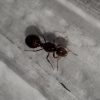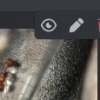Camponotus sexguttatus
Camponotus sexguttatus is a widespread tropical species native from Argentina to the Caribbean islands. It was introduced to southeastern Florida in the late 20th century and has been spreading quickly, now covering about a third of the state. Their species name sexguttatus means "six spots" because in some populations they have three pairs of spots on the side of the gaster. In Florida however, most specimens have only two or four spots. I had a journal of this species previously, but it was a dual journal with my colony of Camponotus inaequalis and there was only one queen. I have deleted the C. sexguttatus posts on that journal and converted it to a journal on just the inaequalis because I felt that it was confusing the way it was. I figured I'd start over new with C. sexguttatus because it's been a while since I've kept them and I've wanted a polygynous Camponotus colony for a while.
June 30, 2021
On this day I received a group of Camponotus sexguttatus queens from a friend who lives on the east coast of Florida because I do not have this species in my part of the state. There were 6 queens but one of them died or got killed during shipping. At this point they only had eggs.
July 16, 2021
Today there is a nicely sized brood pile. Three pupae and more on the way.




Edited by Aaron567, December 18 2021 - 10:14 AM.





























